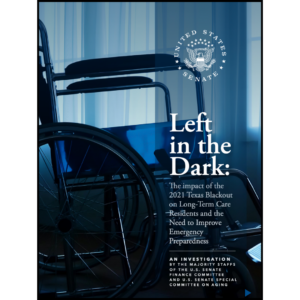Cost – Effective Purchasing: Advice From a GPO
| Shifting focus from item pricing can yield greatest savings |
| The current staffing crunch and trend toward revenue reduction in long-term care mean that administrators and managers must fill several different roles, including that of purchasing or materials manager. These professionals are motivated to reduce supply costs as much as possible to help improve their facilities’ financial performance while providing maximum value to residents. When a long-term care facility aims to reduce supply costs, a common practice is to look at the cost of individual items and attempt to find the low-cost supplier for each item. However, this approach often adds cost to the purchasing process. Here’s why:
Purchasing related products-such as food, office supplies and medical supplies-by group rather than by line item enables a long-term care facility to achieve more attractive pricing by purchasing larger volumes from fewer suppliers. Working with a smaller number of selected suppliers also cuts down on the staff time needed to analyze purchases and deal with paperwork and deliveries. To establish a process that shifts the focus of purchasing away from line-item prices and provides a more complete perspective on supply costs, here are some questions a long-term care facility’s leadership needs to answer: On which supply categories does the facility spend the most money? The answer to this question will focus attention on the supply categories that are likely to have the greatest potential for cost savings. After identifying these categories, gather data to identify the top-volume items within each category. Compare current and potential suppliers’ prices on these high-use items, as shown in the example in Table 1. If a potential vendor’s prices for top-volume items are attractive-as vendor B’s prices are in Table 1-the staff should spend a minimal amount of time reviewing and negotiating prices for the lower-volume items. This means that while the staff spends time analyzing the cost of items that can provide the greatest savings because of volume, time spent analyzing the cost of items that could only provide smaller savings is minimized. Are we considering all acceptable potential suppliers? This can be the most difficult step in the process because it involves change. For most products, many suppliers offer acceptable quality and service, but the staff uses only a few suppliers because of tradition or habit. This can substantially limit a facility’s ability to realize cost savings. One way to eliminate a bias toward established suppliers is to bring in other suppliers’ products for a trial period. If necessary, “blind” trials can help staff overcome their predetermined ideas about the quality of various suppliers’ products. What other costs are associated with purchasing supplies? The answer to this question (Table 2) should include an analysis of payment terms, freight charges, minimum order requirements and other relevant factors, such as transportation ownership, restocking charges or required shipping quantities. The staff should also consider any price protection agreements offered by suppliers. If a supplier will hold the price of an item steady for a certain amount of time, it can have a significant positive impact on long-term savings. Can changes of supplier be accomplished in an effective time frame? It might be tempting to assign responsibility for analyzing costs and implementing all supplier changes to one member of a facility’s leadership team. However, such a workload would probably require that person to focus on only the largest cost-saving opportunities-which often take considerable time to implement because of the changes involved and multiple departments impacted-while overlooking some savings opportunities that are smaller but easier to accomplish. Provided that staffing is available, a solution would be to assign responsibility for different product categories to different members of the team. By focusing on a single product category, the assigned team members should be able to consider both large and small savings opportunities within the category. In addition, regular meetings of the entire purchasing team will enable team members to share ideas, communicate expected outcomes and learn from each other’s experiences. Although the savings from this process can be considerable, it might seem too much to add to the workload of an overburdened staff. A practical alternative is to work with a group purchasing organization (GPO). The detailed cost analysis described earlier is exactly what effective GPOs do for their members. The prices a GPO can negotiate are likely to be even more attractive than those any single facility can achieve because GPOs consolidate the purchasing volume of dozens, hundreds or even thousands of facilities. In addition, with the support of a GPO, a facility’s staff can devote the time that would have been spent in supply procurement and cost analysis to resident care or customer service. If a long-term care facility does decide to handle the cost-analysis process independently, one more question that leadership should ask is: How will we monitor savings to ensure that prices won’t escalate? Conducting a periodic review of supplier invoices by checking them against the original product cost analysis is one solution. Questioning and resolving any discrepancies serve to remind suppliers that the facility is determined to save on supply costs. After the staff members of a long-term care facility become familiar with and experienced in the cost-analysis process, they should meet regularly to identify ad-ditional product categories for consideration. This responsibility can be assigned to a value-analysis committee, which can consider all product categories over time and otherwise champion the process. NH Mary Starr is director of alternate care for Consorta Catholic Resource Partners, Rolling Meadows, Ill. Consorta is a group purchasing organization that serves more than 2,100 health facilities, including more than 300 extended-care facilities. For more information, visit www.consorta.com. |
I Advance Senior Care is the industry-leading source for practical, in-depth, business-building, and resident care information for owners, executives, administrators, and directors of nursing at assisted living communities, skilled nursing facilities, post-acute facilities, and continuing care retirement communities. The I Advance Senior Care editorial team and industry experts provide market analysis, strategic direction, policy commentary, clinical best-practices, business management, and technology breakthroughs.
I Advance Senior Care is part of the Institute for the Advancement of Senior Care and published by Plain-English Health Care.
Related Articles
Topics: Articles , Facility management , Operations











